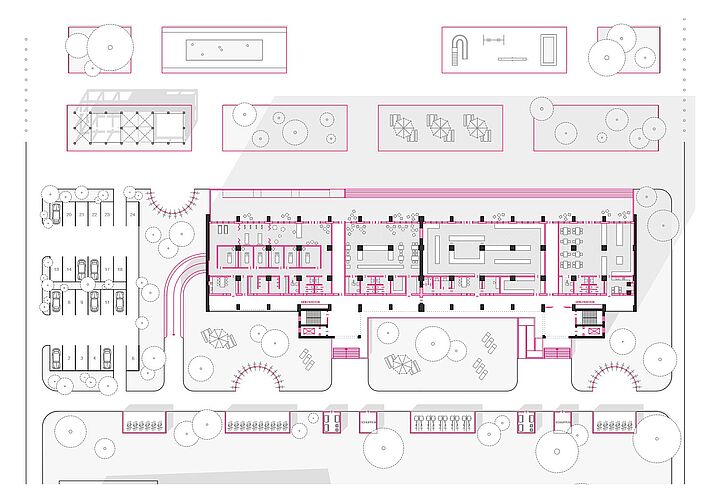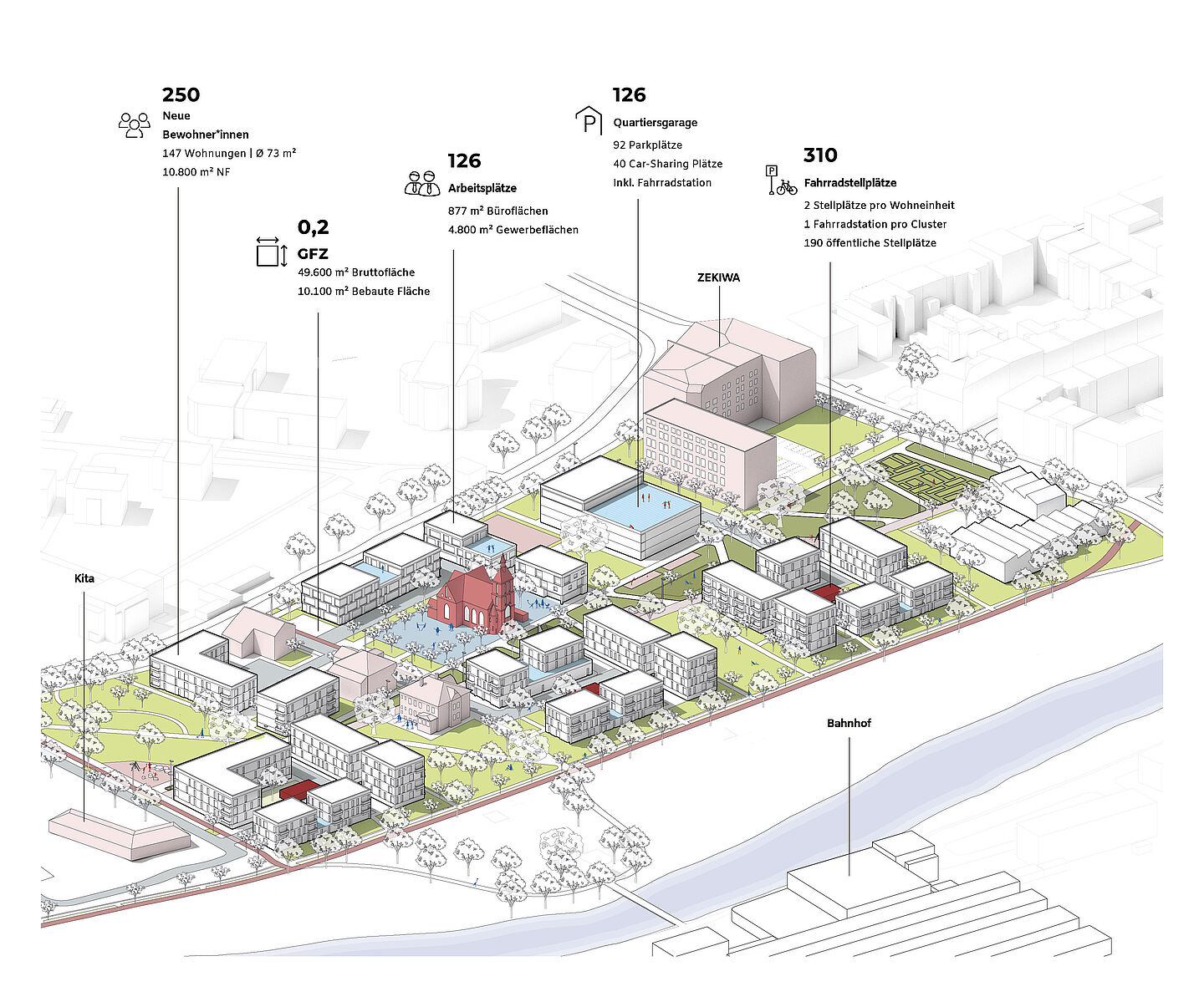HTWK Study Award for Architecture 2024
MINUTES OF THE JURY MEETING
The jury will meet on 09.01.2023 at 12:00 h in room LI 427 of the HTWK Leipzig architecture floor. It consists of the following persons:
- Johann Bierkandt, architect Weimar
- Matthias Grunwald, Professor for Urban Design, Leipzig
- Norbert Hippler, Architect Leipzig
- Falk Saalbach, architect, Leipzig
- Maribel Sengewald, architect Munich
Prof. Grunwald is elected chairman of the jury (4 votes in favour, 1 abstention). Nancy Jehmlich from the Architecture Methods Department was appointed as secretary. A total of 28 projects were submitted. All submitted works were admitted for evaluation. The list of authors of the works with the identification numbers 1 to 28 is attached to these minutes.
Presentation by the authors
In a first information round (12:45 to approx. 17:00), the submitted works were presented by the students in short presentations (3 - 4 minutes), giving the jury the opportunity to ask non-judgemental questions about the content.
The jury unanimously noted that the architectural standard was remarkable and the diversity of the tasks was impressive. The structured presentations and the high level of attention from the students present were favourably received.
Elimination rounds
In the subsequent elimination rounds, the works were assessed by the judges as follows:
1st round:
The following works were eliminated in the 1st round despite individual advocates. The following works were eliminated in the first round:
1, 3, 4, 6, 7, 10, 11, 15, 17, 18, 19, 22, 24, 25 and 26
2nd round:
The remaining works were discussed in more detail and compared with each other. The jury unanimously concluded that the works in the 2nd round reached a very high architectural level and were characterised by special conceptual approaches. After intensive discussion of the strengths and weaknesses, the following works were eliminated: 12, 16, 20 and 28.
Shortlist
The following works therefore remain on the shortlist: 2, 5, 8, 9, 14, 23
After intensive, comparative discussion of the shortlisted works, the following distribution of prizes and awards was unanimously agreed:
Prize distribution
Three prizes and three commendations will be awarded.
Prize money totalling € 1,650 will be distributed. The originally planned prize money of € 1,500 was increased by € 150.
Jury assessment of the award-winning works / distribution of the prize money
First prize (500,--€)
Richard Billep - SPS-D35
The SPS - D35 project deals with an industrial building constructed in the 1960s in Dresden-Striesen. The skeleton construction made of reinforced concrete was built for the VEB Ma-schinenbauhandel and is to be used as a multi-generational house in the future.
In the view of the jury, the project is very well and convincingly realised on all scales - from the urban design to the individual flats.
Through simple urban planning additions, the heterogeneous urban space is reorganised in favour of a clearly defined, public neighbourhood square. The new square takes on social functions in the neighbourhood. Due to the communal uses on the ground floor, the ground floor is naturally interlinked with the public space.
The organisation of the standard storeys is characterised by an efficient arcade access and three different types of flats, which are well adapted to the static-constructive specifications of the existing building.
The jury was impressed by the careful way in which the existing building was treated as a listed building. Only the slightly too large, round windows in the existing stairwells were criticised.
The work is very legible and convincingly presented - a project that exemplifies the architectural potential of the existing building.
Second prize (400,-- €)
Aaron Knaak - House in Iceland
The starting point for Aron Knaak's design was an already built reference project - the house in Uehera by architect Kazuo Shinohara, 1976 - from whose physical components a building of its own was to be created after detailed analysis.
According to the author, the House in Iceland enters into an architectural dialogue with itself and its surroundings. It explores the themes of balance and stability
From the jury's point of view, the project is assessed as a spatial experiment that makes no claim to realisation. The work is characterised by its radical simplicity. The balance in the arrangement of the elements creates tension and perfect balance at the same time. Nothing is too much - nothing is too little.
A beautiful work whose spatial quality is conveyed in a special way by the model.
Third prize (300,-- €)
Erik Siebenaller, Tobias Ju-Sin Beck - Grüner Keil Zeitz
Differentiated public open spaces and a recognisable urban density are the characteristics of the small, car-free neighbourhood on the site of the former Kinderwa-genfabrik in Zeitz.
The two authors have succeeded very well in reorganising the now derelict site and developing it in stages with independent urban building blocks. The proposed residential courtyards promote the neighbourhoods due to their good scale. Together with the existing buildings and the former church in the centre of the quarter, they offer the city of Zeitz an identity-creating and innovative quarter.
The jury appreciates the very good and clear presentation of the ideas. A proud achievement for the 3rd semester Bachelor.
ACKNOWLEDGEMENTS
Mina Raschiatore - Architecture in the landscape (€150)
The landscape painting "A storm in the Rocky Mountains" by the American landscape painter Albert Bierstadt (1830 - 1902) was to be complemented with an architecture in the correct perspective.
Mina Raschiatore achieves this artistic addition brilliantly. Based on an analysis of the composition and the graphic marking of the horizon, she not only continues the painting intelligently, but also abstracts it superbly. The mountain landscape with the storm clouds is transformed into a new ambiguity by the abstract composition of simple broken wooden strips.
The connection between the vertical architectural objects and the sky, the new spatial depth and the subtle use of colour lend the painting a metaphorical character.
The jury praised the successful composition.
Lukas Rüß - Neue Bahnen ziehen, Sportmuseum Leipzig (€150)
The fragment of the north stage of the former swimming stadium is to be converted into the Leipzig Sports Museum. Lukas Rüß has developed a high-quality design and spatial-functional concept in which he takes up the 1950s grandstand as an architectural figure and, in dialogue with the location, arranges it in such a way that a sophisticated museum is created.
The jury recognised the interpretation of the former grandstand, in which the outer form becomes the inner form. The clear ground plan, the open, museum-like character of the rooms and the atmospheric lighting are to be emphasised. The author has achieved a good balance between respectful treatment of the existing building and new spatial proposals.
The work is outstanding and convincingly presented.
Only the lack of historical reference in the new building structure does not appear to have been consistently thought through to the end and was discussed controversially by the jury.
Overall, the complex transformation of the swimming centre into a sports museum is an exemplary master project at a high level.
Nicola Hendler, Julie de Parade - Wackerbögen wine pavilion (€150)
The design of an innovative pavilion made of rammed earth for the Schloss Wacker-barth winery in Radebeul near Dresden was the subject of the design task.
The authors present a coherent spatial concept in which an underground wine cellar characterised by vaults is made visible and positioned as an independent pavilion in the baroque garden of Wackerbarth Castle. In the view of the jury, the proposed location is well chosen
The jury appreciates the way in which the special material requirements of the rammed earth are addressed, which is used not only for the walls but also as a barrel shell for the roof construction. In addition, the "arches" utilise familiar architectural motifs and appear natural and familiar.
While the model studies illustrate the authors' intentions well, the reduced presentation is controversial. An atmospheric representation could illustrate the design qualities and materiality even better.



